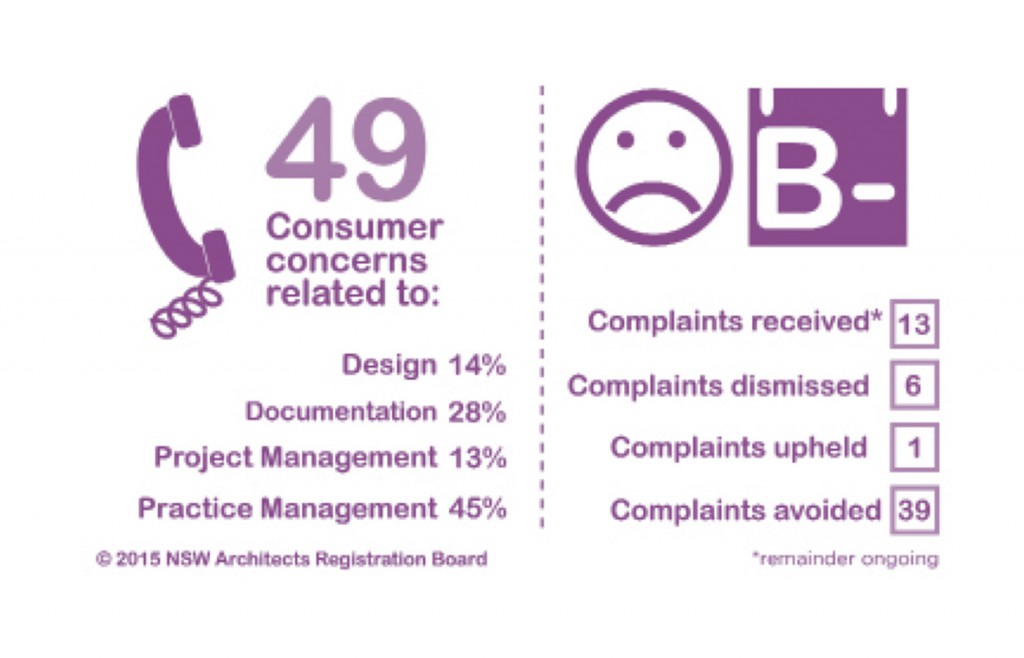



table of contents

previous articles

next articles
Feature article



CONTENTS
When exactly did architects give up on learning? When did professional development become a dirty word? And why is it that an industry which builds real things with real knowledge for real people seems to be hitting the target while missing the point when it comes to sharing what it knows?
Last year, almost half of all enquiries to the Board from homeowners were about poor practice management by their architects. Another 28% related to problems with documentation. So imagine our surprise when an architect tells us they have no need for professional development. They’ve done it for so long they know it all. Really?
At one level, CPD is (just) a measure of how an architect learns, grows and improves. But can we measure how the profession learns, grows and improves? CPD is important. As it is for doctors, lawyers and the rest. Often, it involves sharing mistakes. So do architects make mistakes? Does anyone know why architects don’t or won’t do post-occupancy evaluation, let alone share the results? Post-surgical follow up is required for doctors. Heck, even cars go back for a tune-up after purchase. So how do architects learn, develop and refine their skills, and tune their performance over time?
In 2003, when the then Minister for Fair Trading, Reba Meagher introduced the Architects Bill to NSW parliament, she made it clear that the Act was intended to do three things; provide greater consumer protection, more effective professional discipline and enable the Board to take a more active role in promoting community discussion on the role of architects.
Bucking a trend in deregulation at the time, protection of the title ‘architect’ was extended by the Act on condition that architects signed on to two things in return; to remain ‘covered’ and ‘current’. ‘Covered’ meant that insurance would provide protection for consumers in the event something went wrong. And staying ‘current’ would mean consumers would know their architect is operating at the frontier of the competencies that define them; design, documentation, project delivery and practice management. Both of these distinguish architects from building designers, yet both are generally regarded by architects as costly at best. Drudgery, more likely.
Staying current is about continually building on the knowledge gained at university, applied in practical experience after graduation, tested through the registration process, and improved through an architect’s life. This should be a cinch. Through the projects they design, visit, see and study, generations of architects have shaped the discipline’s standards and practices. Construction technologies and new materials evolve through R&D sketched on yellow trace and applied on site. An architect’s sketch kickstarts a supply chain of materials, technologies, services, manufacturers, suppliers, and trades. For every $100 spent by a client, $8 goes to the consultant, $12 to the head contractor and a whopping $80 goes to subcontractors and their materials.1 The least cost centre creates the greatest value upstream and work for supply networks downstream.
This image of the architect at the centre of production should mean they have the greatest insight into why things go right and where they go wrong. NSW Fair Trading figures show 6% of all building-related complaints are due to design faults. What kind? What’s the actual cause? Can we halve these faults over the next two years? Around 65% of defects are related to workmanship. Where? Can these be designed out?
Just imagine if project data was systematically gathered and shared? Wouldn’t this add value to the profession as a whole? Could it spawn new enterprises – like the US practice Duvall Decker who launched a facilities management company to learn first-hand from their projects? Isn’t this a model for how to learn, grow and improve?
Each year, the Board reviews a snapshot of CPD undertaken that year. An algorithm selects 5% of all practicing architects to report. This sample builds a picture of how the profession likes to learn. There’s the usual smattering of slip resistance, product presentations, and the national architecture conference. Architects are required to develop in at least two of the four units of competency and they’re expected to develop a plan for the year ahead.
Audits are just a compliance mechanism to ensure architects hold up their end of a bargain made with the government in 2003. The bigger question is how and when will the profession get serious about developing a knowledge culture that shares data and learns from its mistakes? The need is urgent, as policymakers around the country see evidence in mounting defect claims that the sector isn’t learning. CPD needs nothing less than a total overhaul if the industry is to keep its side of the bargain.
Tim Horton is the registrar of the NSW Architects Registration Board












